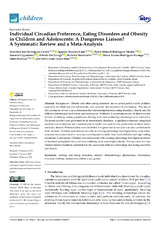Mostrar el registro sencillo del ítem
Individual Circadian Preference, Eating Disorders and Obesity in Children and Adolescents: A Dangerous Liaison? A Systematic Review and a Meta-Analysis
| dc.contributor.author | Rodríguez-Cortés, Francisco José | |
| dc.contributor.author | Morales Cané, Ignacio | |
| dc.contributor.author | Rodríguez Muñoz, Pedro Manuel | |
| dc.contributor.author | Cappadona, Rosaria | |
| dc.contributor.author | Giorgi, Alfredo De | |
| dc.contributor.author | Manfredini, Roberto | |
| dc.contributor.author | Rodríguez Borrego, M.A. | |
| dc.contributor.author | Fabbian, Fabio | |
| dc.contributor.author | López Soto, Pablo Jesús | |
| dc.date.accessioned | 2022-01-31T14:06:51Z | |
| dc.date.available | 2022-01-31T14:06:51Z | |
| dc.date.issued | 2022 | |
| dc.identifier.uri | http://hdl.handle.net/10396/22398 | |
| dc.description.abstract | Obesity and other eating disorders are an actual public health problem, especially in childhood and adolescents, and could be also related with chronotype. The aim of this systematic review was to determine the relationship between eating disorders, obesity and the different chronotypes in children and adolescents. Methods: A systematic review of observational studies evaluating young populations dealing with and evaluating chronotype was conducted. Electronic searches were performed in six international databases. A qualitative thematic-categorical analysis was carried out and a random-effects model was used for the quantitative analysis (meta-analysis). Results: Fifteen studies were included, but quantitative analysis was only carried out in three of them. Children and adolescents with an evening chronotype had higher body mass index, consumed more junk food or were more predisposed to suffer from food addiction and night eating syndrome. Conclusions: Children and adolescents with evening chronotype had higher tendency to incorrect eating behaviors and were suffering from overweight/obesity. Environment but also lifestyle factors should be considered in the association between chronotype and eating disorders and obesity. | es_ES |
| dc.format.mimetype | application/pdf | es_ES |
| dc.language.iso | eng | es_ES |
| dc.publisher | MDPI | es_ES |
| dc.rights | https://creativecommons.org/licenses/by/4.0/ | es_ES |
| dc.source | Children 9(2), 167 (2022) | es_ES |
| dc.subject | Feeding and eating disorders | es_ES |
| dc.subject | Obesity | es_ES |
| dc.subject | Chronobiology | es_ES |
| dc.subject | Phenomena | es_ES |
| dc.subject | Chronotype | es_ES |
| dc.subject | Circadian rhythms | es_ES |
| dc.subject | Adolescents | es_ES |
| dc.subject | Children | es_ES |
| dc.subject | Sex | es_ES |
| dc.subject | Gender | es_ES |
| dc.title | Individual Circadian Preference, Eating Disorders and Obesity in Children and Adolescents: A Dangerous Liaison? A Systematic Review and a Meta-Analysis | es_ES |
| dc.type | info:eu-repo/semantics/article | es_ES |
| dc.relation.publisherversion | https://doi.org/10.3390/children9020167 | es_ES |
| dc.rights.accessRights | info:eu-repo/semantics/openAccess | es_ES |

